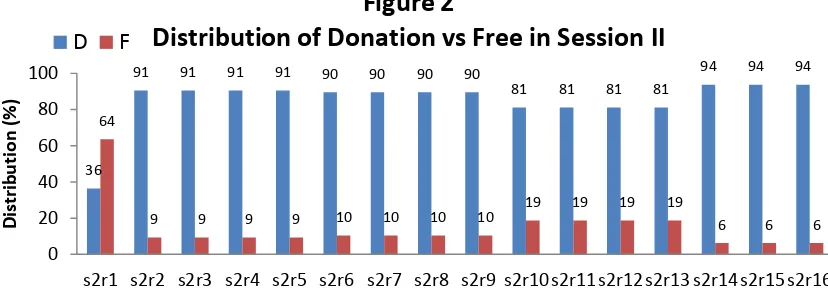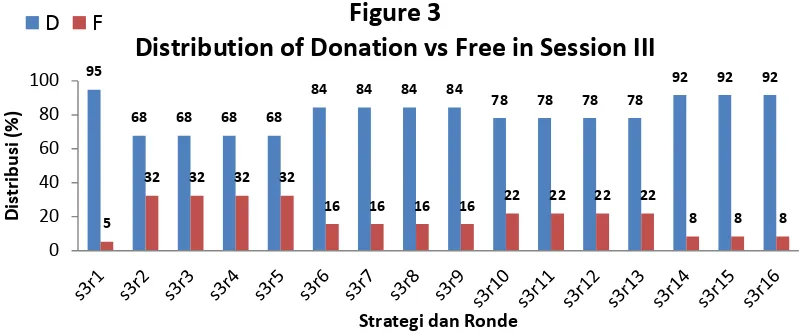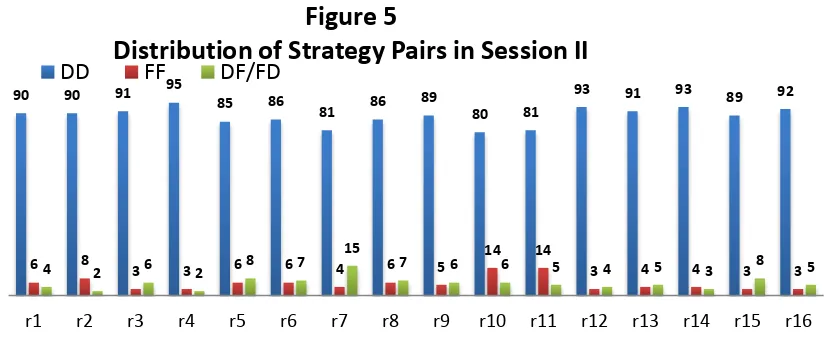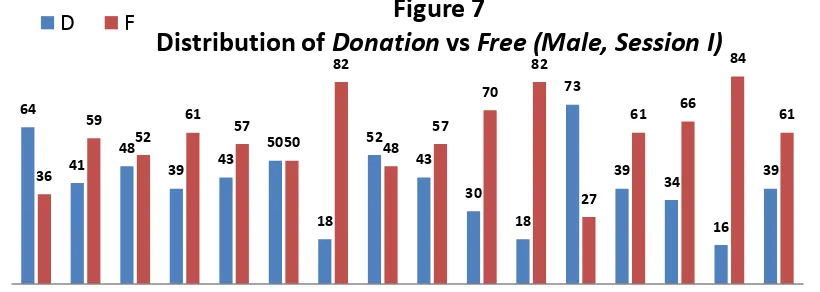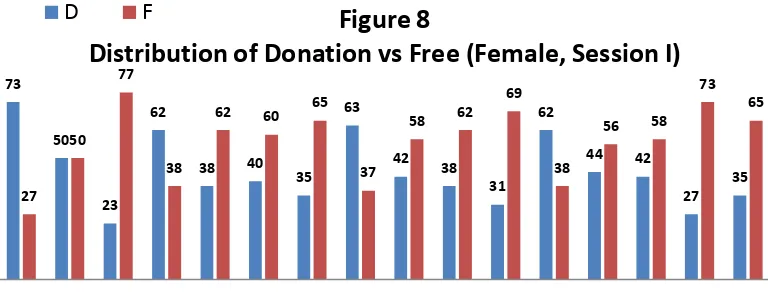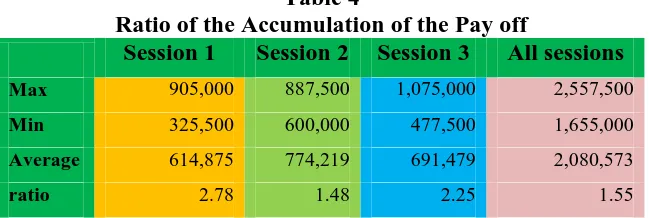An Experiment of Public Goods Provision through Prisoner's Dilemma Game: are Students Homo economicus?
Bambang Suprayitno Universitas Negeri Yogyakarta
bambang_s@uny.ac.id Tejo Nurseto
Universitas Negeri Yogyakarta tejo@uny.ac.id
Ngadiyono
Universitas Negeri Yogyakarta ngadiyonoadi@gmail.com
ABSTRACT
A provision of public goods risks free-rider problem because of one of its properties, non excludability. The property allows noone to exclude anyone to consume the goods. Therefore, it will threaten the availability of the public good itself. Purpose of this study is to determine the economic behavior of community members. Other than that, it aims to know the differences in the economic behavior men and women the provision. It also explores behavioral changes that occur when a tranparancy and grouping rule are carried out. This research was conducted through an experiment of the provision of public goods utilizing the Prisoner's Dilemma game scenarios. The game was applied for three sessions, where each session consisted of 16 rounds that everyround had unique payoff table. Session I, each participant didn’t know whom he paired with. Session II, the participants were allowed to know his couple and can negotiated each other. Session III, the participant acted as a member of a group. This experiment was conducted by students in three classes and 32 students per class. The result shows dominance homo economicus behavior. It is only 21% of participant couples to choose donation, the contribution rate is lower than the previous studies. There is no significant difference between men and women. When the rules of transparency applied the rule, it increases significantly the role of the community in making a donation in the provision of public goods compared it in session I.
Keywords: public goods, the prisoner's dilemma, experiment
INTRODUCTION
parties who utilize the benefits, however they do not want to contribute to provide the public goods (Rosen & Gayer, 2008).
To view this homo economicus behavior, it is necessary to design research that could be used to uncover the economic behavior of individuals in society. Prisoner’s dilemma (PD) is a form of game theory is best applied in order to see the coordination of economic actors. The actors are given the freedom to play a dominant role where it is their authority (Cooper, Dejong, & Forsyth, 1996). PD is a strategy game that is very well known. The name of this game emerged from a story involving criminal suspects. Participants in this game have approximately the same situation with the accused in the criminal story (Osborne, 2000).
Behaviors associated with the provision of public goods are Altruism, Warm-glow, Homo economicus, and Free Rider. Respectively, they show the attitude that increase selfishness. Selfishness is only concentrating on the interests of the welfare of yourself regardless of others. The righter the more selfish, the lefter the person erodes the selfish even he does not think about himself.
Economists assume that people will make a choice to maximize their objective. Therefore man who has this conduct will be called homo economicus since he concerns with self-serving, his own purpose, or as a rational individual in both the classical and neoclassical theory (Furubotn, Eirik G & Richter, 2001). Homo economicus is absolutely rational that put blinders, really selfish and can easily solve the problem of difficult issues with optimization (Levitt & List, 2008).
Altruism is a belief that is not selfish or concern about the welfare of others. In his study, Andreoni et al (2007) found that there was still plenty of evidence of the nature of altruism exists in public. He noted that this trait can emerge from hisself, the first, indeed of its origin depends on the culture. This evidence showed that different people (nation) were also different in the behavior of their altruist. The second, in revealing the nature of the goods, it requires the development of psychology and socialization from an early age, and the latter, can naturally be born when there was concern.
Andreoni et al (2007) found that apart from internal factors obtained from laboratory experiments, the nature of this altruism appears also in the real world outside the laboratory. Through field research as well as in fundraising, this was tangible evidence presented by List and Lucking Reily in his research in 2002.
According to Andreoni (1990), warm-glow are contributions to provide public goods based on social pressure, sympathy, guilt, desire to gain prestige, friendship, or honor. Warm-glow is a form of altruism that is no longer pure. This happens because he gives and has the purpose to provide public goods to all people but also for his own interests. An interesting definition that could be used as an argument distinguishing between altruism and egoism was as expressed by Batson and Shaw (1991):
achievable goal to get another goal. Finally, Increasing another's or one's own, this third key specifically distinguish whether the motivation is altruistic or selfish, it depends on the person who gets the benefits, yourself or someone else.
A study conducted by Belot et al (Belot, Duch, & Miller, 2010) showed that the economic actors who school have a tendency of higher homo economicus than the other economic actors who does not school. This happens because they have ability to apply knowledge of the strategy and their social preferences. This study used various experimental combinations between the classic game experiments namely, the Trust Game, Dictator Game, Public Goods Game and challenging strategy games like Beauty-contest and Second-price Auction.
A study using multiperson prisoner dilemma that includes penalties in the game proved that there is a strong reciprocal relationship between the social scale of the human and the punishment given. Fehr & Fischbacher (2003) suggested the study on this subject cited from the study Henrich and Boyd 2001 and Boyd et al in 2003 showed that in line with the increasing of the scale of members in one group, the cooperation said to be declining precipitously even less than 5% no working at all after members passed 16 people per group. The game applied punishment for dissidents still reach at the range of 50% even after a number of 128 experienced decrease less than 5% of the cooperation. The impact of this punishment significantly showed while the punishment not only carried out by the executor but also the people.
Duersch and Servátka (2007) conducted a study through PD experiment by incorporating elements of emotion and there is a risk to get rewards and punishments (R & P). The findings indicate that there is no relation of the provision of R & P and the choices of players. Moreover it was found that there is a strong correlation of emotions of participants with their choices.
Pradiptyo et al (2011) conducted a study to analyze the behavior of participants in coordination. Looking at the process of evolution in the game PD, results showed that the vast majority tend to choose the dominant strategy as argued by Game Theory. The purposes of this research are to determine the economic behavior of the community members represented by members of the class of experiments, to know exactly the difference of contribution behaviour between men and women, and to explore behavioral changes when the rules of society changed. This study hopefully is able to contribute input and recommendation to policy makers related to economic behavioral in the provision of public goods.
EXPERIMENT DESIGN
Pay-off variation in this PD game refers to the pay-offs were applied by Pradiptyo et al (2011). The participants faced the table pay off, as the following example.
The table was displayed and changed in 16 variations. Thus, the participants faced a unique pay-off which varied in 16 rounds. Pay-off obtained depended on the contributions/donations (D) or not/free rider (F) of the combination of the choices of participant and his partner.
Table 1
Partner
Contribution No Contribution
I
Contribution Me Rp50.000
MyPartner Rp50.000
Me 0 MyPartner Rp87.500
No Contribution Me Rp87.500,
MyPartner 0
Me Rp12.500 MyPartner Rp12.500
This experiment was conducted by students from three public economics classes that had never participated in the experiment with game theory. The activities in the class were carried out in three experimental sessions. Number of the participants are 32 per class, therefore there were 96 participants. Experiment was conducted through three sessions where each session consisted of 16 rounds (with a unique pay-off strategy chosen) where for each round the participants were given 30 second time to decide the choice.
The first session was conducted PD with a rules that there was no coordination and the participant did not know who his partner was. The second session was carried out through coordination among participants and each participant knew who his partner was. Thus, in this second session, both participants had to communicate to decide the choice in every a round.
In the third session, 16 rounds of the games was carried out in the first session and the second sessions repeated but done in a group in which the pair was not between two persons but four persons. In the group, they decided the choices through communicating first.
Recording the results of each experiment, each participant was given a working sheet in the form of table entries from the predetermined selection of three sessions with 16 rounds in every session. After the experiment, the outcome of the game was displayed to see the results. From the results it would be obtained which participants were chosen as person who has behaviour with categories namely Altruism, where the participant contributed the biggest but got the least gain; Warm-glow, where the participant contribute closest to the average and got the gain closest to the average; Homo economicus (rational participant), where the participant got the biggest gain but contributed the least; and Free Rider, the participant who contributed the least but got the biggest gain.
RESULTS AND DISCUSSION
Distribution of Contributions (D) versus Free Rider (F) a. Session I
Overall, results in session I indicated that from minute to minute they contribute less. This is depicted in the following figure where the longer the game was carried out the less the participants who contributed or it indicated the emerging of free riders.
Many participants took the position to be rational person and it emerged bigger and might learn from existing experience. It shows that societies tend to give no contribution in public procurement when there is no binding rules as well as members of the community do not know the conduct of each other. Since this free rider behaviour allowed, it will endanger the provision of public goods where the people will not contribute to provide public goods.
b. Session II
The results showed that the most participants were taking taking contribution position because the change of the rule from the previous position where the previous is no coordination and this session all pair participant must coordinate first to decide. This shows that when there is a care and communication to each other, therefore members of the community tend to cooperate for the provision of public goods and donates funds. Carrying out the new rule, the members can control one another.
69
s1r1 s1r2 s1r3 s1r4 s1r5 s1r6 s1r7 s1r8 s1r9 s1r10s1r11s1r12s1r13s1r14s1r15s1r16
D
Distribution of Donation vs Free in Session I
D F
s2r1 s2r2 s2r3 s2r4 s2r5 s2r6 s2r7 s2r8 s2r9 s2r10 s2r11 s2r12 s2r13 s2r14 s2r15 s2r16
D
Distribution of Donation vs Free in Session II
c. Session III
Result of this round can show that many participants took the donation position because the new rule is diferently than the previous round, especially in the first session. In this third session is open as well as the second session. However, the participants cooperate with the group not only between two individuals. Therefore, they consider the desire of other members in the group.
This case indicates that since there is giving vigilant at the provision of public goods through take care to each other and keep communication then the position taken by members of the public tend to cooperate to contribute funds. Implementing the open rules, the members can control one to another. However, even in this session contribution predominates but it still has more free rider compared to the second session. In this session, passion to compete among the groups appears more than the second session.
Overall, the difference among the sessions shown as the following table:
Table 2
Donation Difference in Each Session
Dependent Variable: DONASIT
Included observations: 48
Variable Coefficient Prob.
C 42.77313 0.0000
Session2 42.44875 0.0000
Session3 37.89437 0.0000
F-statistic 74.75274
Prob(F-statistic) 0.000000
95
68 68 68 68
84 84 84 84
78 78 78 78
92 92 92
5
32 32 32 32
16 16 16 16 22 22 22 22
8 8 8
0 20 40 60 80 100
D
is
tr
ib
u
si
(
%
)
Strategi dan Ronde
Figure 3
Distribution of Donation vs Free in Session III
Distribution of Strategy Pairs a. Session I
In the diagram below, pair strategy appears to increase to take both free rider positions (FF) of the participant pairs. FF pair trend is more and more taken by the participants. This combination contrasts with the strategy of both donations (DD) and a pair Donation-Free Rider (DF/FD).
In general, participants who chose a strategy partner equally donation (DD) is very small and tend to decline, on average it is only 20%. The opposite trend is held by the particpants who take FF. This shows that the participants learn strategies and then implement homo economicusnya behavior. Due to no donation (F position), the participants have the higher probability to get bigger pay-off.
b. Session II
The diagram depicts that the longer the more participants who are taking a stand equally donation (DD). This DD pair tends to be more than 90%. This strategy contrasts with
Distribution of Strategy Pairs in Session I
DD FF DF/FD
Distribution of Strategy Pairs in Session II
The diagram shows that in general, strategy DD is dominant and tends to have an upward trend. The opposite trend is held FF and FD/DF. It indicates a rule that allow participants to communicate the strategy do the best for the members. This condition represents that in the real world with their attention to one another and tends to reduce homo economicus behaviour of the community members.
c. Session III
The diagram above shows that the behavior of participants in session III pefer to contribute. However, the domination of DD strategy is not as strong as previous session (II). This occured because of the competition among the groups, therefore members of the group tend to choose the most profitable strategy for the group itself. Members of the group were expected to unite to take contribution postion.
3. Behavior of Men vs Women a. Session I
As statistics test, behavior between men and women are not different. But in detail, the proportion of donations made by a man less than that done by women. This can be seen in the following diagrams.
76
Distribution of Strategy Pairs in Session III
DD FF DF/FD
s1r1 s1r2 s1r3 s1r4 s1r5 s1r6 s1r7 s1r8 s1r9 s1r10 s1r11 s1r12 s1r13 s1r14 s1r15 s1r16
Figure 7
Distribution of
Donation
vs
Free (Male, Session I)
b. Session II
In the second session, participants tend to make donation. This occurs both by women and men participants. This shows that the existing regulatory changes that may coordinate so effectively change behavior homoeconomikus men and women become more contribute to the provision of public goods. This occurs because of the increase of the care one another, the transparency afford to control each other to prevent free riders.
c. Session III
The two pictures look not significant difference between men and women. In fact, on average, they have the exact same distributions and it has an average distribution of 71% to make a donation and 29% to be free rider.
73
50
23 62
38 40 35
63
42 38
31 62
44 42
27 35 27
50 77
38
62 60 65
37
58 62 69
38
56 58 73
65
s1r1 s1r2 s1r3 s1r4 s1r5 s1r6 s1r7 s1r8 s1r9 s1r10 s1r11 s1r12 s1r13 s1r14 s1r15 s1r16
Figure 8
Distribution of Donation vs Free (Female, Session I)
D F
91 91 93 98 91 93 84 89 89 84 80
93 95 95 95 91
9 9 7
2 9 7
16 11 11 16 20
7 5 5 5 9
s2r1 s2r2 s2r3 s2r4 s2r5 s2r6 s2r7 s2r8 s2r9 s2r10s2r11s2r12s2r13s2r14s2r15s2r16
Figure 9
Distribution of Donation vs Free (Male, Session II)
D F
92 90 92 94 88 87 90 92 94
79 87
96 92 92 92 96
8 10 8 6 12 13 10 8 6 21 13 4 8 8 8 4
s2r1 s2r2 s2r3 s2r4 s2r5 s2r6 s2r7 s2r8 s2r9 s2r10s2r11s2r12s2r13s2r14s2r15s2r16
Figure 10
Distribution of Donation vs Free (Female, Session II)
Difference test of men and women behaviour is depicted as the following table.
Table 3
Different Test of Homoeconomicus Male vs Female Ftest Male vs Female
Session Session 1 Session 2 Session 3 All sessions
Prob 0.729254 0.642545 0.554234 0.819973
This is the table of pay off derived from the activities of public goods provision. Generally it indicates that the ratio of the pay-off is same. This emphasizes the same as well as the previous tables.
Table 4
Ratio of the Accumulation of the Pay off
Session 1 Session 2 Session 3 All sessions Max 905,000 887,500 1,075,000 2,557,500
Min 325,500 600,000 477,500 1,655,000
Average 614,875 774,219 691,479 2,080,573
84
s3r1 s3r2 s3r3 s3r4 s3r5 s3r6 s3r7 s3r8 s3r9 s3r10s3r11s3r12s3r13s3r14s3r15s3r16
Figure 11
Distribution of Donation vs Free (Male, Session III)
D F
s3r1 s3r2 s3r3 s3r4 s3r5 s3r6 s3r7 s3r8 s3r9 s3r10 s3r11 s3r12 s3r13 s3r14 s3r15 s3r16
Figure 12
Distribution of Donation vs Free (Female, Session III)
It shows that in the first session, the rational behaviour gets the biggest among all sessions. The second session, the behavior pressed as it is reflected in declining max values and the value of the ratio. While in the third session of the rational behaviour appears therefore the ratio of max value of the minimum value arise.
CONCLUSION
From the discussions, the points of this research are:
1. In general, people's behavior recorded in this experiment indicates that homo economicus predominates. Pair of all contribution strategy is only 20%. However, the free-rider behavior is greater, it has 37% portion. The rest, the strategy is at least one of the member chose not to contribute.
2. Overall, no significant differences between men and women even when there is a regulation change. In detail, on average, men’s free rider is bigger than women do. Men’s donation portion is at 41% while 43% of women in session I.
3. When there is a change in the rules in force in the community, especially by making more transparancy in provision of public goods, it can encourage the participation in providing the goods. This can happen because the existing system increase awareness and care to each other and encourages thepeople to make a donation.
We can recommend that the provision of public goods can not rely upon public awareness only to give donations in providing public goods. If we do not pay attention and allow the behavior of the free-rider it will tend to spread and infect other members of society so that this behavior will explode or more people who participate do so. To increase the necessary public donations, it requires new rules that do not just persuade but more than that, we need to make transparancy among the members. Hence, public will arise reluctance to run his free-rider behavior.
REFERENCES
Andreoni, J. (1990). Impure Altruism and Donations to Publik Good: A Theory of a Warm-Glow Giving. The Economic Journal Volume 100, Issue 401(Jun. 1990), 464-477.
Andreoni, J., Harbaugh, W. T., & Ves, L. (2007). Altruism in Experiments. the New Palgrave Dictionary of Economics, 2nd Edition.
Batson, C. D., & Shaw, L. L. (1991). Evidence for Altruism: Toward a Pluralism of Prosocial Motives. Psychological Inquiry Vol 2., No 2, 107-122.
Belot, M., Duch, R., & Miller, L. (2010). Who should be called to the lab? A
comprehensive comparison of students and non-students in classic experimental games. University of Oxford, Nuffield College Discussion Papers.
Cooper, R., Dejong, V. D., & Forsyth, R. (1996). Cooperation without Reputation: Experimental Evidence from Prisoner’s Dilemma Games. Games and
Economics Behaviour 12 Article No. 0013., 187–218.
Duersch, P., & Servátka, M. (2007). Risky Punishment and Reward in the Prisoner’s Dilemma. Discussion Paper No.451. University of Hidelberg.
Fehr, E., & Fischbacher, U. (2003). The Nature of Human Altruism. Nature, Vol 425,
Furubotn, Eirik G, E. G., & Richter, R. (2001). Intitutions and Economic Theory: the
Contribution of the New Institutional Economics. Michigan: The University of
Michigan Press.
Hyman, D. N. (2008). Public Finance: A Contemporary Application of Theory to
Policy. 9th Edition. Mason: South-Western Cengage Learning.
Levitt, S. D., & List, J. A. (2008). Homo economicus Evolves. SCIENCE Vol 319 15
February.
Osborne, J. M. (2000). An Introduction to Game Theory. Oxford: Oxford University Press.
Pradiptyo, R., Sasmitasiwi, B., & Sahadewo, G. A. (2011). Evidence of homo economicus? Findings from experiment on evolutionary prisoners' dilemma game. MPRA Paper No. 30480, posted 25 April.
